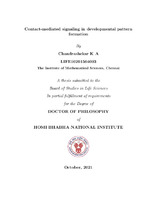- DSpace Home
- →
- IMSc Theses/ Dissertations
- →
- IMSc Theses/ Dissertations
- →
- View Item
JavaScript is disabled for your browser. Some features of this site may not work without it.
| dc.contributor.author | Chandrashekar, K.A. | |
| dc.date.accessioned | 2022-05-11T10:00:57Z | |
| dc.date.available | 2022-05-11T10:00:57Z | |
| dc.date.issued | 2021 | |
| dc.date.submitted | 2021 | |
| dc.identifier.uri | https://dspace.imsc.res.in/xmlui/handle/123456789/596 | |
| dc.description.abstract | Processes that break spatial symmetry to produce patterns are at the heart of embryonic development. These patterns are produced by regulating cell division, migration, differentiation and apoptosis, the four most important processes that drive development. The remarkable consistency in the emergent features across a species in spite of the noise that is inherent to the underlying processes serves as a testimony to the robustness of the mechanisms underlying developmental pattern formation. Relying on amplification of subtle asymmetries that exist in the early embryo, a cascade of symmetry breaking events give rise to an organism which is strikingly different from the fertilized embryo in every aspect, be it size, shape, complexity or function. Often a localized source of specialized molecules called morphogens establish a concentration gradient which aid in partitioning regions in the embryo into different domains characterized by their constituent cells attaining distinct fates. Additional morphogen sources within these domains can divide them further into sub-domains comprising cells that are even more specialized. As most morphogens are also growth factors with the ability to influence cell proliferation, the spatial domains often differ also in terms of their size. While morphogen gradients provide information at length scales corresponding to that of tissues, cells can also communicate over much shorter distances by interacting with their neighbors, for instance using the Notch signaling pathway. Such contact-mediated interactions between adjacent cells and their role in modulating the cellular response to global signals such as those provided by morphogen concentration gradients form the central theme of this thesis. | en_US |
| dc.publisher.publisher | The Institute of Mathematical Sciences | |
| dc.subject | Intercellular Communication | en_US |
| dc.subject | HBNI Th207 | en_US |
| dc.title | Contact-mediated signaling in developmental pattern formation[HBNI Th207] | en_US |
| dc.type.degree | Ph.D | en_US |
| dc.type.institution | HBNI | en_US |
| dc.description.advisor | Sitabhra Sinha | |
| dc.description.pages | 194p. | en_US |
| dc.type.mainsub | Computational Biology | en_US |
| dc.type.hbnibos | Life Sciences |
Files in this item
This item appears in the following Collection(s)
-
IMSc Theses/ Dissertations
IMSc Theses/ Dissertations
